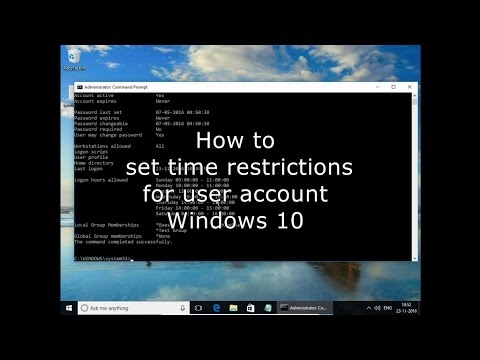Introduction:
In the dynamic digital landscape of Windows 10, users often find themselves seeking effective ways to manage and regulate the usage of individual accounts. Whether you’re a parent wanting to control your child’s screen time or an administrator seeking to enforce productivity measures, setting time limits for accounts in Windows 10 is a powerful tool. This extensive guide will walk you through the step-by-step process of implementing time restrictions on user accounts, ensuring efficient time management and a balanced digital lifestyle.
- Understanding the Importance of Time Limits: As technology becomes an integral part of daily life, striking a balance between screen time and other activities is crucial. Setting time limits for user accounts in Windows 10 helps promote healthier digital habits, prevent excessive usage, and enhance overall well-being.
- Accessing Account Settings: Begin by accessing the account settings on your Windows 10 system. Click on the Start button, followed by the gear-shaped Settings icon. In the Settings menu, select “Accounts” to access user account configurations.
- Creating User Accounts (If Needed): If the user account for which you want to set time limits doesn’t exist, create a new account. Navigate to the “Family & other users” section within Accounts settings and click on “Add someone else to this PC.” Follow the prompts to set up a new user account.
- Enabling Family Safety Features: Windows 10 provides Family Safety features that allow you to manage and monitor accounts efficiently. To enable Family Safety, go to Settings > Accounts > Family & other users. Click on “Manage family settings online” to set up Family Safety through a Microsoft account.
- Setting Up Family Safety Online: Access the Microsoft Family Safety website (family.microsoft.com) to configure time limits and other restrictions. Sign in with your Microsoft account, select the user account for which you want to set limits, and navigate to the “Screen time” section. Here, you can set daily time limits for specific activities.
- Configuring Screen Time Limits: Within the Microsoft Family Safety website, choose the user account you wish to manage, and click on “Screen time.” Set daily time limits for weekdays and weekends, specifying the allowed duration for activities like gaming, browsing, and other screen-related tasks.
- Managing App and Game Limits: In addition to overall screen time limits, Microsoft Family Safety allows you to set specific limits for individual apps and games. Navigate to the “Apps & games” section on the Microsoft Family Safety website, select the desired user account, and configure limits based on the desired parameters.
- Establishing Content Filters: Enhance control over the digital content accessible to user accounts by configuring content filters. Within the Microsoft Family Safety website, go to the “Content filters” section. Tailor filters for age-appropriate content, ensuring a safe and secure online experience.
- Monitoring Activity Reports: Stay informed about user account activities by regularly reviewing activity reports provided by Microsoft Family Safety. These reports offer insights into screen time, app usage, and web browsing, empowering you to make informed decisions regarding time management.
- Enforcing Remote Restrictions: Microsoft Family Safety extends its functionality to remote management. Access the Microsoft Family Safety website from any device, sign in with your Microsoft account, and remotely adjust time limits, content filters, and other restrictions for user accounts.
- Using Local Group Policy Editor (Advanced): For users comfortable with advanced configurations, the Local Group Policy Editor in Windows 10 provides additional options for setting time limits. Open the Local Group Policy Editor by typing “gpedit.msc” in the Run dialog (Win + R). Navigate to Computer Configuration > Windows Settings > Security Settings > Account Policies > Logon Hours to configure time restrictions.
- Setting Time Limits for Standard User Accounts: Windows 10 offers time restrictions primarily through Family Safety features, which may not be available for standard user accounts. To implement time limits for standard accounts, consider using third-party parental control software that provides enhanced features for managing screen time.
- Customizing Time Limits for Different Days: Microsoft Family Safety allows for the customization of time limits based on specific days. Tailor daily schedules to accommodate varying routines, ensuring that time limits align with the desired screen time allocation for weekdays and weekends.
- Educating Users on Time Management: Establish open communication with users, especially in the case of children or shared devices. Educate them about the importance of responsible screen time management, and involve them in the process of setting realistic and fair time limits.
- Regularly Reviewing and Adjusting Limits: As user habits and requirements evolve, it’s essential to periodically review and adjust time limits accordingly. Regularly revisit the Microsoft Family Safety website or other parental control tools to ensure that time restrictions align with current needs.
Conclusion:
Setting time limits for accounts in Windows 10 is a proactive and responsible approach to managing screen time and promoting a balanced digital lifestyle. Whether you’re a parent fostering healthy online habits for your children or an administrator optimizing productivity measures, the tools provided by Windows 10, especially through Microsoft Family Safety, offer versatile options for efficient time management.
As you embark on the journey of implementing time restrictions, remember that flexibility and communication are key. Strive to strike a balance that respects individual needs while ensuring a mindful and productive use of digital resources. By leveraging the features inherent in Windows 10 and supplementary tools where needed, users can master time management, fostering a digital environment that aligns with their values and priorities.
